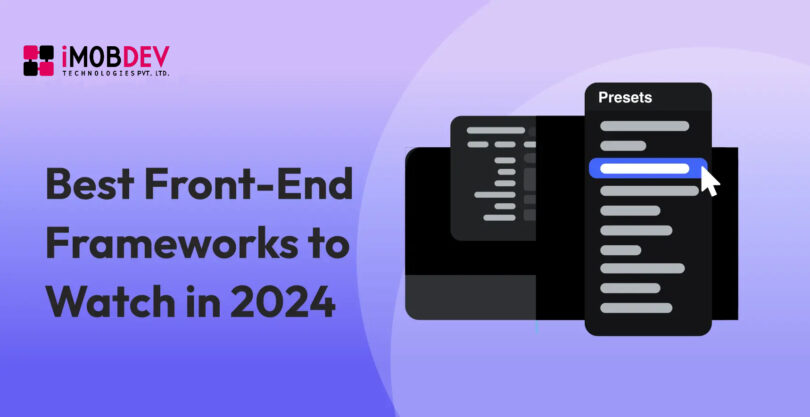Top Frontend Frameworks
Frontend development has become an integral aspect of crafting web applications. It equips developers with ready-made components, libraries, and utilities that streamline the creation of dynamic and user-friendly interfaces. By harnessing the power of frontend frameworks, developers can enhance the performance of their applications and expedite the development workflow.
This piece delves into the foremost choices for front-end development in 2024.
Best 10 Frontend Frameworks
1. React
When considering hiring front-end developers, it’s crucial to acknowledge React’s significance. Although React is technically a JavaScript library primarily used for crafting user interfaces, it commonly receives the moniker of a frontend framework. Originating in 2011, it was brought to life by Jordan Walke, an adept Facebook developer. Transitioning into open-source territory in 2013, React commenced its ascent in popularity. Presently, corporate juggernauts like PayPal, Netflix, Walmart, Tesla, and others opt for React in their front-end development endeavors. This widespread adoption attests to the framework’s remarkable quality and dependability.
Frontend developers who opt for React harness the power of JavaScript alongside declarative coding practices. Noteworthy is JSX, an exclusive feature permitting the utilization of HTML for streamlined DOM (Document Object Model) updates and Virtual DOM creation, culminating in heightened performance.
2. Angular
When aiming to hire web developers, it’s important to consider Angular, an influential open-source frontend development framework initiated by Google back in 2010. Angular consistently secures its place on the roster of well-regarded front-end frameworks. This standing is well-deserved, given its robust performance and an array of functional attributes like directives, filters, two-way data binding, dependencies, and additional capabilities.
Prominent enterprises like BMW and Forbes opt for Angular as the foundation for their applications, underscoring the exceptional caliber of this framework.
3. JQuery
In the realm of front-end development frameworks, jQuery stands as a veteran presence. While technically categorized as a library, akin to React, jQuery possesses certain attributes aligning it with a framework’s role. Originating in 2006, jQuery remains an enduringly popular tool, maintaining its relevance amidst contemporary alternatives.
Within the domain of frontend development companies, jQuery holds its significance. Programmers leverage the jQuery framework to heighten user interface interactivity, manipulating CSS and DOM elements, managing events, animations, AJAX requests, and an array of functionalities. Esteemed entities like LinkedIn, Twitter, and Slack reportedly integrate jQuery within their products.
4. Vue.js
Within the landscape of JavaScript frontend frameworks, Vue.js emerges as a particularly promising contender. Vue.js marked its initial debut in 2015.
The arrival of Vue 3.0 in 2020 was a highly anticipated moment resonating with developers globally, and the version certainly lived up to those expectations. Vue 3.0 underwent a comprehensive rewrite, now harnessing the prowess of TypeScript. This transition yields heightened advantages in facilitating agile development. Furthermore, the framework’s packages have been streamlined, presenting smaller footprints. Novel APIs have been introduced to tackle expansive tasks effectively. Notably, Vue extends support for Server-Side Rendering (SSR), thereby expanding the horizons of development possibilities within the purview of web development company.
5. Bootstrap
In the realm of front-end development, Bootstrap shines as an open-source CSS framework originating from Twitter. Its popularity is rooted in its user-friendly nature, adaptability across various browsers and devices, and a responsive design ethos.
Comprising HTML, CSS, and JavaScript elements, Bootstrap incorporates a treasure trove of pre-constructed components, templates, and utilities. This arsenal empowers developers to craft an extensive array of UI elements and layouts with ease.
6. Material Design Lite
Material Design Lite (MDL) emerges as a front-end framework hailing from Google, firmly rooted in the principles of Material Design. Its core purpose revolves around facilitating the seamless creation of visually captivating websites, ensuring a uniform visual identity across diverse platforms and devices.
The framework equips developers with an assortment of CSS classes, JavaScript components, and ready-to-use UI elements that impeccably align with Material Design precepts. This array encompasses an array of UI elements including buttons, cards, dialog boxes, navigation menus, and more. Constructed with HTML, CSS, and JavaScript, MDL seamlessly integrates into a spectrum of web projects, granting developers an enhanced toolkit for design consistency.
7. Bulma
Bulma, an open-source CSS framework rooted in Flexbox principles, emerges as a formidable tool for developers seeking to forge effortlessly responsive, mobile-centric websites.
Distinguished by its exclusive reliance on CSS, Bulma eliminates the need for JavaScript dependencies. At its core, the framework boasts an expansive array of CSS classes and pre-fabricated UI components, all thoughtfully engineered to offer both adaptability and customization. Among these components, you’ll discover forms, tables, cards, menus, and an assortment of other building blocks essential for crafting dynamic web experiences.
8. Semantic UI
Semantic UI emerges as a front-end framework leveraging HTML to craft websites that seamlessly adapt and can be personalized. Its primary objective revolves around simplifying the process for developers to fashion user interfaces that are both instinctive and responsive, requiring minimal input.
Distinguished by its potency and adaptability, Semantic UI presents a robust toolkit for front-end development. It champions a semantic design approach, complemented by an extensive assortment of pre-constructed components. These components empower the creation of contemporary, responsive web applications and websites, aligned with the demands of modern digital landscapes.
9. Foundation
Foundation stands out as a widely embraced front-end development framework, furnishing an array of resources and functionalities essential for constructing adaptable and personalized websites and web applications. Its architecture draws upon the trio of HTML, CSS, and JavaScript, and its core objective is to streamline the creation of intricate web interfaces by expediting and simplifying the development process.
10. UIKit
UIkit emerges as a front-end framework originating from YOOtheme, furnishing an assortment of adaptable and modular components indispensable for shaping contemporary and responsive user interfaces. Constructed through the integration of HTML, CSS, and JavaScript, UIkit delivers an array of utilities and functionalities simplifying the creation of visually appealing and functional web applications and websites.
Conclusion
In the ever-evolving landscape of web development, the choice of a front-end framework holds paramount importance. As we navigate through 2024, several standout contenders continue to shape the way we design and build web interfaces. From React’s declarative elegance to Angular’s robust architecture, the options are diverse and dynamic. Meanwhile, jQuery’s enduring relevance and Vue.js’ innovative TypeScript-powered approach showcase the industry’s adaptability. Being a top web and app development companies we have qualified professionals who can analyze your development requirements and create the best solution for you leveraging their profound knowledge and proficient development skills.







